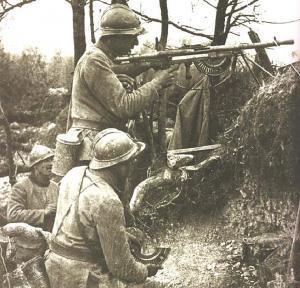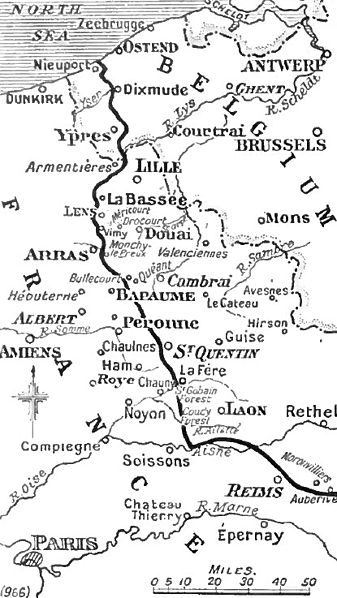Niitä valmistui Aisne joen taistelun alku 208 kpl ja vuoden 1916 aikana kaikkiaan 400.
Ranskalaisten toinen, St Chamond tankki, valmistui Aisne joen taistelun alkuun mennessä ja niitä oli 48 kpl, mutta nämä osallistuivat vasta myöhempiin taisteluihin.
Ranskalaiset SchneiderC1 tankit osallistuivat 16.4. 1917 taisteluun ww-1 sodan aikana ensimmäisen kerran Reimsin lähellä, Aisne-joen pohjois puolella.
Hyökkäykseen lähti 850.000 miestä. Näiden tukena oli 5000 tykkiä, useita tuhansia konekivääreitä, lentokoneita ja 200 Schneider C1 tankkia.

French 'Chauchat' 1915 Machine Gun
Hotchkiss Model 1914 (Mle 1914)

French Self-propelled anti-aircraft mounting
Saksalaiset vastasivat tankkien hyökkäykseen käyttäen jopa 200 mm tykkien suoran tulen menetelmää, vaunuhin joden panssari oli tarkoitettu kiväärin luotien torjuntaan.
Lisäksi saksalaiset käyttivät ilmatorjunta tykkejä, haupitseja, raskaita konekivääreitä
miinanheittimiä, muiden pienempien kenttä tykkien ohella joiden ammuksia tankkien
ohut yksinkertainen panssarilevy ei kestänyt.

A 7.58 cm Minenwerfer
Schneider tankkien takana oleva polttoaine säiliö oli erityisen haavoittuva ja alkoi vuotaa hyvin herkästi vaunun päälle, jolloin vaunut leimahtivat tuleen.
Tämän ansiosta vaunu sai lempinimen, "Liikkuva krematorio".
Teknisten vikojen johdosta taisteluun ehti osallistua vain 132 panssarivaunua.
Kaksi päivää kestäneiden taistelujen aikana niistä tuhoutui vielä 76 vaunua.
Vaunujen menestys oli heikko, koska saksalaiset olivat ottaneet oppia brittien tankki hyökkäyksestä ja järjestäneet kenttätykkejä panssarivaunujen torjuntaan aivan kuten
Camprain taisteluissa joten vaunujen menestys oli heikko jalkaväen tuen puuttuessa.
The left flank division of the XXXII Corps and the right division of the V Corps penetrated the German second position south of Juvincourt but French tanks attacking south of the Miette from Bois de Beau Marais advanced to disaster.
German observers at Craonne, on the east end of the Chemin des Dames, were able to direct artillery-fire against the tanks and 23 were destroyed behind the French front line; few of the tanks reached the German defences and by the evening only ten tanks were operational. On the left flank the V Corps was stopped at the Bois des Boches and the hamlet of la Ville aux Bois. On the Chemin des Dames, I Corps made very little progress and by evening had advanced no further than the German support line, 200–300 yards (180–270 m) ahead.
The French infantry had suffered many casualties and few of the leading divisions were capable of resuming the attack. The advance had failed to reach objectives which were to have fallen by 9:30 a.m. but 7,000 German prisoners had been taken.
St.Chamond tank
On the second day Nivelle ordered the Fifth Army to attack north-eastwards to reinforce success, believing that the Germans intended to hold the ground in front of the Sixth Army.


Schneider CD-3 Tractor
The German retirement was carried out urgently and many guns were left behind, along with "vast" stocks of munitions.
The French infantry reached the new German positions with an advance of 4 miles
But the result was a disaster.
Many found the rough terrain was too much for their tracks and their forward rail acted to overhang the hull, prone to ditch itself in any solid obstacle. The engine was not powerful enough and many broke down at the very beginning.
The others advanced in broad daylight and the Germans deployed a lethal artillery barrage, and used field guns at short range in direct fire, firing on flat trajectories against tanks which were designed to only sustain machine-gun and infantry fire.
The others advanced in broad daylight and the Germans deployed a lethal artillery barrage, and used field guns at short range in direct fire, firing on flat trajectories against tanks which were designed to only sustain machine-gun and infantry fire.
Eventually the Germans quickly learned to target the exposed forward gasoline reserve and many burst into flames, earning the infamous nickname of "Mobile Crematoriums".
A total of 57 CA-1s were lost that day. 44 broke down at the start and the remainder managed to reach their objectives, breaking through German first and second lines.
A total of 57 CA-1s were lost that day. 44 broke down at the start and the remainder managed to reach their objectives, breaking through German first and second lines.
However poor coordination meant that the infantry failed to support them and retreated.
Only 56 survived.







Ei kommentteja:
Lähetä kommentti
Any explosive ammunition or empty cores, you can put in this.